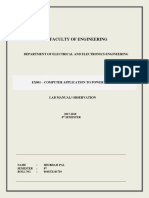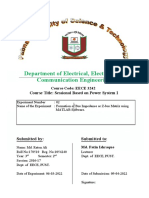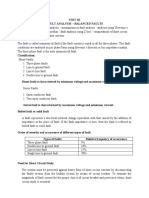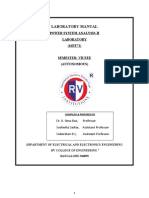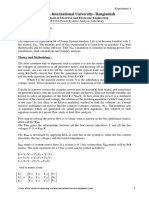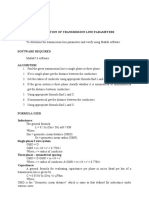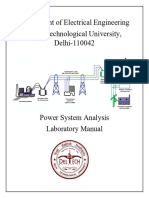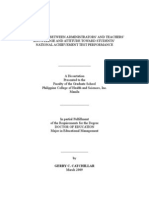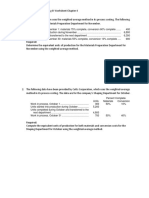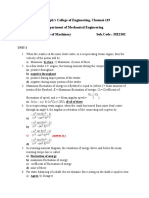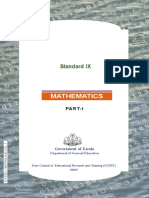DEDAN KIMATHI UNIVERSITY OF
TECHNOLOGY
Electrical and Electronics Engineering Department
Power system Laboratory Exercises
Prepared by
Dr Lucas Mogaka
� EXP NO: 1
FORMATION OF BUS ADMITTANCE AND IMPEDANCE MATRICES AND
SOLUTION OF NETWORKS
AIM:
To develop a program to obtain Ybus matrix for the given networks by the method of inspection.
FORMATION OF Y-BUS MATRIX
Generalized [Y-Bus] Yii Yij
=
Y ji Yjj
Each admittance Yii (i =1,2……n) is called the self-admittance or driving point admittance of
bus I and equals the sum of all admittances terminating on the particular bus.
Each off-diagonal term Yij (i,j = 1,2…n; ji) is the transfer admittance between buses I and j,
n=total number of buses. Further, Yij = Yji
SIMULATION
In this exercise matrix, Z-Bus for the system is developed by first forming the Ybus and then
inverting it to get the Z-Bus matrix. The generator and transformer impedances are taken into account.
Ybus is a sparse matrix, Z-Bus is a full matrix, i.e., zero elements of Ybus become non-zero
values in the corresponding Z-Bus elements. The bus impedance matrix is most useful for short circuit
studies.
ALGORITHM
Step (1): Initialize [Y-Bus] matrix that is replace all entries by zero.
Yij = Yij-yij = Yji = off diagonal element
n
Step (2): Compute Yii = y ij = diagonal element.
j =1
Step (3) : Modify the Ybus matrix by adding the transformer and the generator admittance
Page 2 of 28
�Step (4) : Compute the Z-Bus matrix by inverting the modified Ybus matrix.
START
Read no of buses(NB),No of
lines (NL) & line Data
Initialize Y Bus Matrix
Consider Line l=1
i = sb(l); j = eb(l)
Y(i,i) = Y(i,i) + yseries(l) +0.5 ysh(l)
Y(j,j) = Y(j,j) + yseries(l) +0.5 ysh(l)
l=l+1 Is
Modify the Ybus by adding generator and transformer
admittances to the respective diagonal elements.
Compute the Z-bus matrix by inverting modified
Ybus
Print all the Results
STOP
Page 3 of 28
� 1. The [Y-Bus] matrix is formed by inspection method for a four-bus system. The line data and is
given below.
LINE DATA
Line SB EB Series Impedance Line charging
Number (p.u) Admittance (p.u)
1 1 2 0.10 + j0.40 j0.015
2 2 3 0.15 + j0.60 j0.020
3 3 4 0.18 + j0.55 j0.018
4 4 1 0.10 + j0.35 j0.012
5 4 2 0.25 + j0.20 j0.030
Manual Calculation:
Page 4 of 28
� FORMATION OF Y-BUS BY THE METHOD OF INSPECTION
PROGRAM:
clc;
clear all;
n=input('Enter number of buses');
l=input('Number of lines');
s=input('1.Impedance or 2:Admittance');
ybus=zeros(n,n);
lc=zeros(n,n);
for i=1:l
a=input('Starting bus:');
b=input('Ending bus:');
t=input('Admittance or Impedance of line:');
lca=input('Line charging admittance:');
if(s==1)
y(a,b)=1/t;
else
y(a,b)=t;
end
y(b,a)=y(a,b);
lc(a,b)=lca;
lc(b,a)=lc(a,b);
end
for i=1:n
for j=1:n
if i==j
for k=1:n
ybus(i,j)=ybus(i,j)+y(i,k)+lc(i,k)/2;
end
else
ybus(i,j)=-y(i,j);
end
1
end
end
ybus
Page 5 of 28
�RESULT:
Thus the program for the Ybus formation by the method of inspection was executed and
the output is verified with the manual calculation.
Page 6 of 28
�EXP NO: 2
AIM:
FORMATION OF BUS IMPEDANCE MATRICES
To develop a program to obtain the Z bus matrix for the given network by the method of bus building
algorithm.
FORMATION OF Z-BUS MATRIX
Z-Bus matrix is an important matrix used in different kinds of power system studies such as short
circuit study, load flow study, etc.
In short circuit analysis, the generator and transformer impedances must be taken into account. In
contingency anal ysis, the shunt elements are neglected while forming the Z-Bus matrix, which is used to
compute the outage distribution factors.
This can be easil y obtained by inverting the Ybus formed by inspection method or by analytical
method.Taking inverse of the Ybus for large systems is time consuming; Moreover, modification in the
system requires the whole process to be repeated to reflect the changes in the system. In such cases, the
Z-Bus is computed by Z-Bus building algorithm.
ALGORITHM:
Step 1: Start the program.
Step 2: Read the number of buses, starting bus and ending bus.
Step 3: Initialize the Z Bus matrix.
Step 4: Form the Z – Bus matrix as follows
Case 1:
When a new bus of impedance Zb is connected to reference bus Zbus,new = [ Zb ]
Page 7 of 28
�Case 2: Adding new bus p to existing bus q
Zbus,new = Zorig Z1q
Z2q
..
Zq1 Zq2 …… Zqq+ Zb
Case 3: Adding impedance from an existing bus to reference bus.
Zjk,act = Zjk – Zj(n+1)* Z(n+1)k
Z(n+1)(n+1)
Case 4: Adding Zb between two existing buses h and q
Zbus,new = Zorig Z1h - Z1q
Z2h – Z2q
Zh1 – Zq1 Zh2 – Zq2 ........ Z(n+1)(n+1)
Case 5: Print the Z – bus matrix.
Page 8 of 28
�Problem:
Find the bus impedance matrix for the given network
Page 9 of 28
�EXP. NO: 3
SOLUTION OF POWER FLOW USING GAUSS-SEIDEL METHOD
Page 10 of 28
�Program
%Gauss Sedial
clc;
data=[1 1 2 10-j*20
2 1 3 10-j*30
3 2 3 16-j*32]
elements=max(data(:,1));
bus=max(max(data(:,2)),max(data(:,3)));
y=zeros(bus,bus);
for p=1:bus,
for q=1:elements,
if(data(q,2)==p|data(q,3)==p)
y(p,p)=y(p,p)+data(q,4);
end
end
end
for p=1:bus,
Page 11 of 28
� for q=1:bus,
if (p~=q)
for r=1:elements
if((data(r,2)==p&data(r,3)==q)|(data(r,2)==q&data(r,3)==p))
y(p,q)=-(data(r,4));
end
end
end
end
end
a1=input('enter p2 in MW:');
b1=input('enter q2 in MVAR:');
a2=input('enter p3 in MW:');
b2=input('enter q3 in MVAR');
pu=input('enter the base value in MVA');
p2=(a1/pu);
q2=(b1/pu);
p3=(a2/pu);
q3=(b2/pu);
dx1=1+j*0;
dx2=1+j*0;
v1=1.05;
v2=1+j*0;
v3=1+j*0;
iter=0;
disp('iter v2 v3');
while(abs(dx1)&abs(dx2)>=0.00001)&iter<7;
iter=iter+1;
g1=(((p2-j*q2)/conj(v2))+(-y(1,2)*v1)+(-y(2,3)*v3))/y(2,2);
g2=(((p3-j*q3)/conj(v3))+(-y(1,3)*v1)+(-y(2,3)*g1))/y(3,3);
dx1=g1-v2;
dx2=g2-v3;
v2=v2+dx1;
v3=v3+dx2;
fprintf ('%g',iter),disp([v2,v3]);
end
MANUAL CALCULATION
Page 12 of 28
�EXP NO: 4
DATE:
SYMMETRIC AND UNSYMMERTICAL FAULT ANALYSIS
AIM:
To become familiar with modeling and analysis of power systems under faulted condition and to compare
the fault level, post-fault voltages and currents for different types of faults, both symmetric and
unsymmetric.
OBJECTIVES
To conduct fault analysis on a given system using software available and obtain fault analysis report with
fault level and current at the faulted point and post-fault voltages and currents in the network for the
following faults.
1. Line-to-Ground
2. Line-to-Line
3. Double Line-to-Ground
SINGLE LINE-TO-GROUND FAULT
Page 13 of 28
�Sequence Network of Single line-to-ground-fault
Fault Current
LINE-TO-LINE FAULT
Page 14 of 28
�Sequence Network of Line-to-Line Fault
DOUBLE LINE-TO-GROUND FAULT
Page 15 of 28
�Sequence of Double line-to-ground fault
Page 16 of 28
�PROBLEM:
The one line diagram of a simple power system is shown in the figure. The neutral of
each generator is grounded through a current limiting reactor of 0.25/3 per unit on a
100MVA base. The system data expressed in per unit on a common 100MVA base is
tabulated below. The generators are running on no load at their rated voltage and rated
frequency with their emf’s in phase.
Determine the fault current for the following faults.
a) A balanced three phase fault at bus 3 through a fault impedance Zf=j0.1 per unit.
b) A single line to ground fault at bus 3 through a fault impedance Zf=j0.1 per unit.
c) A line to line fault at bus 3 through a fault impedance Zf=j0.1 per unit.
d) A double line to ground fault at bus 3 through a fault impedance Zf=j0.1 per unit.
Item Base MVA Voltage Rating X1 X2 X0
G1 100 20kV 0.15 0.15 0.05
G2 100 20kV 0.15 0.15 0.05
T1 100 20kV/220kV 0.1 0.1 0.1
T2 100 20kV/220kV 0.1 0.1 0.1
L12 100 220kV 0.125 0.125 0.3
L13 100 220kV 0.15 0.15 0.35
L23 100 220kV 0.25 0.25 0.7125
Manual Calculation:
Page 17 of 28
�PROGRAM:
zdata1 = [0 1 0 0.25
0 2 0 0.25
1 2 0 0.125
1 3 0 0.15
2 3 0 0.25];
zdata0 = [0 1 0 0.40
0 2 0 0.10
1 2 0 0.30
1 3 0 0.35
2 3 0 0.7125];
zdata2 = zdata1;
Zbus1 = zbuild(zdata1)
Zbus0 = zbuild(zdata0)
Zbus2 = Zbus1;
symfault(zdata1,Zbus1)
lgfault(zdata0, Zbus0, zdata1, Zbus1, zdata2, Zbus2)
llfault(zdata1, Zbus1, zdata2, Zbus2)
dlgfault(zdata0, Zbus0, zdata1, Zbus1, zdata2, Zbus2)
symfault
function symfaul(zdata, Zbus, V)
nl = zdata(:,1); nr = zdata(:,2); R = zdata(:,3);
X = zdata(:,4);
nc = length(zdata(1,:));
if nc > 4
BC = zdata(:,5);
elseif nc ==4, BC = zeros(length(zdata(:,1)), 1);
end
ZB = R + j*X;
nbr=length(zdata(:,1)); nbus = max(max(nl), max(nr));
if exist('V') == 1
if length(V) == nbus
Page 18 of 28
� V0 = V;
else, end
else, V0 = ones(nbus, 1) + j*zeros(nbus, 1);
end
fprintf('\Three-phase balanced fault analysis \n')
ff = 999;
while ff > 0
nf = input('Enter Faulted Bus No. -> ');
while nf <= 0 | nf > nbus
fprintf('Faulted bus No. must be between 1 & %g \n', nbus)
nf = input('Enter Faulted Bus No. -> ');
end
fprintf('\nEnter Fault Impedance Zf = R + j*X in ')
Zf = input('complex form (for bolted fault enter 0). Zf = ');
fprintf(' \n')
fprintf('Balanced three-phase fault at bus No. %g\n', nf)
If = V0(nf)/(Zf + Zbus(nf, nf));
Ifm = abs(If); Ifmang=angle(If)*180/pi;
fprintf('Total fault current = %8.4f per unit \n\n', Ifm)
%fprintf(' p.u. \n\n', Ifm)
fprintf('Bus Voltages during fault in per unit \n\n')
fprintf(' Bus Voltage Angle\n')
fprintf(' No. Magnitude degrees\n')
for n = 1:nbus
if n==nf
Vf(nf) = V0(nf)*Zf/(Zf + Zbus(nf,nf)); Vfm = abs(Vf(nf));
angv=angle(Vf(nf))*180/pi;
else, Vf(n) = V0(n) - V0(n)*Zbus(n,nf)/(Zf + Zbus(nf,nf));
Vfm = abs(Vf(n)); angv=angle(Vf(n))*180/pi;
end
fprintf(' %4g', n), fprintf('%13.4f', Vfm),fprintf('%13.4f\n', angv)
end
fprintf(' \n')
fprintf('Line currents for fault at bus No. %g\n\n', nf)
fprintf(' From To Current Angle\n')
fprintf(' Bus Bus Magnitude degrees\n')
for n= 1:nbus
%Ign=0;
for I = 1:nbr
if nl(I) == n | nr(I) == n
if nl(I) ==n k = nr(I);
elseif nr(I) == n k = nl(I); end
if k==0
Ink = (V0(n) - Vf(n))/ZB(I);
Inkm = abs(Ink); th=angle(Ink);
%if th <= 0
if real(Ink) > 0
fprintf(' G '), fprintf('%7g',n), fprintf('%12.4f', Inkm)
fprintf('%12.4f\n', th*180/pi)
Page 19 of 28
� elseif real(Ink) ==0 & imag(Ink) < 0
fprintf(' G '), fprintf('%7g',n), fprintf('%12.4f', Inkm)
fprintf('%12.4f\n', th*180/pi)
else, end
Ign=Ink;
elseif k ~= 0
Ink = (Vf(n) - Vf(k))/ZB(I)+BC(I)*Vf(n);
%Ink = (Vf(n) - Vf(k))/ZB(I);
Inkm = abs(Ink); th=angle(Ink);
%Ign=Ign+Ink;
%if th <= 0
if real(Ink) > 0
fprintf('%7g', n), fprintf('%10g', k),
fprintf('%12.4f', Inkm), fprintf('%12.4f\n', th*180/pi)
elseif real(Ink) ==0 & imag(Ink) < 0
fprintf('%7g', n), fprintf('%10g', k),
fprintf('%12.4f', Inkm), fprintf('%12.4f\n', th*180/pi)
else, end
else, end
else, end
end
if n==nf
fprintf('%7g',n), fprintf(' F'), fprintf('%12.4f', Ifm)
fprintf('%12.4f\n', Ifmang)
else, end
end
resp=0;
while strcmp(resp, 'n')~=1 & strcmp(resp, 'N')~=1 & strcmp(resp, 'y')~=1 &
strcmp(resp, 'Y')~=1
resp = input('Another fault location? Enter ''y'' or ''n'' within single quote
-> ');
if strcmp(resp, 'n')~=1 & strcmp(resp, 'N')~=1 & strcmp(resp, 'y')~=1 &
strcmp(resp, 'Y')~=1
fprintf('\n Incorrect reply, try again \n\n'), end
end
if resp == 'y' | resp == 'Y'
nf = 999;
else ff = 0; end
end % end for while
lgfault
function lgfault(zdata0, Zbus0, zdata1, Zbus1, zdata2, Zbus2, V)
if exist('zdata2') ~= 1
zdata2=zdata1;
else, end
if exist('Zbus2') ~= 1
Zbus2=Zbus1;
else, end
nl = zdata1(:,1); nr = zdata1(:,2); nl0 = zdata0(:,1);
nr0 = zdata0(:,2); nbr=length(zdata1(:,1)); nbus =
max(max(nl), max(nr)); nbr0=length(zdata0(:,1));
Page 20 of 28
�R0 = zdata0(:,3); X0 = zdata0(:,4);
R1 = zdata1(:,3); X1 = zdata1(:,4);
R2 = zdata1(:,3); X2 = zdata1(:,4);
for k=1:nbr0
if R0(k)==inf | X0(k) ==inf
R0(k) = 99999999; X0(k) = 99999999;
else, end
end
ZB1 = R1 + j*X1; ZB0 = R0 + j*X0;
ZB2 = R2 + j*X2;
if exist('V') == 1
if length(V) == nbus
V0 = V;
else, end
else, V0 = ones(nbus, 1) + j*zeros(nbus, 1);
end
fprintf('\nLine-to-ground fault analysis \n')
ff = 999;
while ff > 0
nf = input('Enter Faulted Bus No. -> ');
while nf <= 0 | nf > nbus
fprintf('Faulted bus No. must be between 1 & %g \n', nbus)
nf = input('Enter Faulted Bus No. -> ');
end
fprintf('\nEnter Fault Impedance Zf = R + j*X in ')
Zf = input('complex form (for bolted fault enter 0). Zf = ');
fprintf(' \n')
fprintf('Single line to-ground fault at bus No. %g\n', nf)
a =cos(2*pi/3)+j*sin(2*pi/3);
sctm = [1 1 1; 1 a^2 a; 1 a a^2];
Ia0 = V0(nf)/(Zbus1(nf,nf)+Zbus2(nf, nf)+ Zbus0(nf, nf)+3*Zf); Ia1=Ia0; Ia2=Ia0;
I012=[Ia0; Ia1; Ia2];
Ifabc = sctm*I012;
Ifabcm = abs(Ifabc);
fprintf('Total fault current = %9.4f per unit\n\n', Ifabcm(1))
fprintf('Bus Voltages during the fault in per unit \n\n')
fprintf(' Bus -------Voltage Magnitude ---------------\n')
fprintf(' No. Phase a Phase b Phase c \n')
for n = 1:nbus
Vf0(n)= 0 - Zbus0(n, nf)*Ia0;
Vf1(n)= V0(n) - Zbus1(n, nf)*Ia1;
Vf2(n)= 0 - Zbus2(n, nf)*Ia2;
Vabc = sctm*[Vf0(n); Vf1(n); Vf2(n)];
Va(n)=Vabc(1); Vb(n)=Vabc(2); Vc(n)=Vabc(3);
fprintf(' %5g',n)
fprintf(' %11.4f', abs(Va(n))),fprintf(' %11.4f', abs(Vb(n)))
fprintf(' %11.4f\n', abs(Vc(n)))
end
fprintf(' \n')
fprintf('Line currents for fault at bus No. %g\n\n', nf)
fprintf(' From To -----Line Current Magnitude --------- \n')
fprintf(' Bus Bus Phase a Phase b Phase c \n')
for n= 1:nbus
Page 21 of 28
� for I = 1:nbr
if nl(I) == n | nr(I) == n
if nl(I) ==n k = nr(I);
elseif nr(I) == n k = nl(I); end
if k ~= 0
Ink1(n, k) = (Vf1(n) - Vf1(k))/ZB1(I);
Ink2(n, k) = (Vf2(n) - Vf2(k))/ZB2(I);
else, end
else, end
end
for I = 1:nbr0
if nl0(I) == n | nr0(I) == n
if nl0(I) ==n k = nr0(I);
elseif nr0(I) == n k = nl0(I); end
if k ~= 0
Ink0(n, k) = (Vf0(n) - Vf0(k))/ZB0(I);
else, end
else, end
end
for I = 1:nbr
if nl(I) == n | nr(I) == n
if nl(I) ==n k = nr(I);
elseif nr(I) == n k = nl(I); end
if k ~= 0
Inkabc = sctm*[Ink0(n, k); Ink1(n, k); Ink2(n, k)];
Inkabcm = abs(Inkabc); th=angle(Inkabc);
if real(Inkabc(1)) > 0
fprintf('%7g', n), fprintf('%10g', k),
fprintf(' %11.4f', abs(Inkabc(1))),fprintf(' %11.4f',
abs(Inkabc(2)))
fprintf(' %11.4f\n', abs(Inkabc(3)))
elseif real(Inkabc(1)) ==0 & imag(Inkabc(1)) < 0
fprintf('%7g', n), fprintf('%10g', k),
fprintf(' %11.4f', abs(Inkabc(1))),fprintf(' %11.4f',
abs(Inkabc(2)))
fprintf(' %11.4f\n', abs(Inkabc(3)))
else, end
else, end
else, end
end
if n==nf
fprintf('%7g',n), fprintf(' F'),
fprintf(' %11.4f', Ifabcm(1)),fprintf(' %11.4f', Ifabcm(2))
fprintf(' %11.4f\n', Ifabcm(3))
else, end
end
resp=0;
while strcmp(resp, 'n')~=1 & strcmp(resp, 'N')~=1 & strcmp(resp, 'y')~=1 &
strcmp(resp, 'Y')~=1
resp = input('Another fault location? Enter ''y'' or ''n'' within single quote
-> ');
if strcmp(resp, 'n')~=1 & strcmp(resp, 'N')~=1 & strcmp(resp, 'y')~=1 &
strcmp(resp, 'Y')~=1
fprintf('\n Incorrect reply, try again \n\n'), end
Page 22 of 28
� end
if resp == 'y' | resp == 'Y'
nf = 999;
else ff = 0; end
end % end for while
llfault
function llfault(zdata1, Zbus1, zdata2, Zbus2, V)
if exist('zdata2') ~= 1
zdata2=zdata1;
else, end
if exist('Zbus2') ~= 1
Zbus2=Zbus1;
else, end
nl = zdata1(:,1); nr = zdata1(:,2);
R1 = zdata1(:,3); X1 = zdata1(:,4);
R2 = zdata2(:,3); X2 = zdata2(:,4);
ZB1 = R1 + j*X1; ZB2 = R2 + j*X2;
nbr=length(zdata1(:,1)); nbus = max(max(nl), max(nr));
if exist('V') == 1
if length(V) == nbus
V0 = V;
else, end
else, V0 = ones(nbus, 1) + j*zeros(nbus, 1);
end
fprintf('\nLine-to-line fault analysis \n')
ff = 999;
while ff > 0
nf = input('Enter Faulted Bus No. -> ');
while nf <= 0 | nf > nbus
fprintf('Faulted bus No. must be between 1 & %g \n', nbus)
nf = input('Enter Faulted Bus No. -> ');
end
fprintf('\nEnter Fault Impedance Zf = R + j*X in ')
Zf = input('complex form (for bolted fault enter 0). Zf = ');
fprintf(' \n')
fprintf('Line-to-line fault at bus No. %g\n', nf)
a =cos(2*pi/3)+j*sin(2*pi/3);
sctm = [1 1 1; 1 a^2 a; 1 a a^2];
Ia0=0;
Ia1 = V0(nf)/(Zbus1(nf,nf)+Zbus2(nf, nf)+Zf); Ia2=-Ia1;
I012=[Ia0; Ia1; Ia2];
Ifabc = sctm*I012;
Ifabcm = abs(Ifabc);
fprintf('Total fault current = %9.4f per unit\n\n', Ifabcm(2))
fprintf('Bus Voltages during the fault in per unit \n\n')
fprintf(' Bus -------Voltage Magnitude ---------------\n')
fprintf(' No. Phase a Phase b Phase c \n')
for n = 1:nbus
Vf0(n)= 0;
Vf1(n)= V0(n) - Zbus1(n, nf)*Ia1;
Vf2(n)= 0 - Zbus2(n, nf)*Ia2;
Page 23 of 28
�Vabc = sctm*[Vf0(n); Vf1(n); Vf2(n)];
Va(n)=Vabc(1); Vb(n)=Vabc(2); Vc(n)=Vabc(3);
fprintf(' %5g',n)
fprintf(' %11.4f', abs(Va(n))),fprintf(' %11.4f', abs(Vb(n)))
fprintf(' %11.4f\n', abs(Vc(n)))
end
fprintf(' \n')
fprintf('Line currents for fault at bus No. %g\n\n', nf)
fprintf(' From To -----Line Current Magnitude---- \n')
fprintf(' Bus Bus Phase a Phase b Phase c \n')
for n= 1:nbus for
I = 1:nbr
if nl(I) == n | nr(I) == n
if nl(I) ==n k = nr(I);
elseif nr(I) == n k = nl(I); end
if k ~= 0
Ink0(n, k) = 0;
Ink1(n, k) = (Vf1(n) - Vf1(k))/ZB1(I);
Ink2(n, k) = (Vf2(n) - Vf2(k))/ZB2(I);
Inkabc = sctm*[Ink0(n, k); Ink1(n, k); Ink2(n, k)];
Inkabcm = abs(Inkabc); th=angle(Inkabc);
if real(Inkabc(2)) < 0
fprintf('%7g', n), fprintf('%10g', k),
fprintf(' %11.4f', abs(Inkabc(1))),fprintf(' %11.4f',
abs(Inkabc(2)))
fprintf(' %11.4f\n', abs(Inkabc(3)))
elseif real(Inkabc(2)) ==0 & imag(Inkabc(2)) > 0
fprintf('%7g', n), fprintf('%10g', k),
fprintf(' %11.4f', abs(Inkabc(1))),fprintf(' %11.4f',
abs(Inkabc(2)))
fprintf(' %11.4f\n', abs(Inkabc(3)))
else, end
else, end
else, end
end
if n==nf
fprintf('%7g',n), fprintf(' F'),
fprintf(' %11.4f', Ifabcm(1)),fprintf(' %11.4f', Ifabcm(2))
fprintf(' %11.4f\n', Ifabcm(3))
else, end
end
resp=0;
while strcmp(resp, 'n')~=1 & strcmp(resp, 'N')~=1 & strcmp(resp, 'y')~=1 &
strcmp(resp, 'Y')~=1
resp = input('Another fault location? Enter ''y'' or ''n'' within single quote
-> ');
if strcmp(resp, 'n')~=1 & strcmp(resp, 'N')~=1 & strcmp(resp, 'y')~=1 &
strcmp(resp, 'Y')~=1
fprintf('\n Incorrect reply, try again \n\n'), end
end
if resp == 'y' | resp == 'Y'
nf = 999;
Page 24 of 28
� else ff = 0; end
end % end for while
dlgfault
function dlgfault(zdata0, Zbus0, zdata1, Zbus1, zdata2, Zbus2, V)
if exist('zdata2') ~= 1
zdata2=zdata1;
else, end
if exist('Zbus2') ~= 1
Zbus2=Zbus1;
else, end
nl = zdata1(:,1); nr = zdata1(:,2); nl0 = zdata0(:,1);
nr0 = zdata0(:,2); nbr=length(zdata1(:,1)); nbus =
max(max(nl), max(nr)); nbr0=length(zdata0(:,1));
R0 = zdata0(:,3); X0 = zdata0(:,4);
R1 = zdata1(:,3); X1 = zdata1(:,4);
R2 = zdata2(:,3); X2 = zdata2(:,4);
for k = 1:nbr0
if R0(k) == inf | X0(k) == inf
R0(k) = 99999999; X0(k) = 999999999;
else, end
end
ZB1 = R1 + j*X1; ZB0 = R0 + j*X0;
ZB2 = R2 + j*X2;
if exist('V') == 1
if length(V) == nbus
V0 = V;
else, end
else, V0 = ones(nbus, 1) + j*zeros(nbus, 1);
end
fprintf('\nDouble line-to-ground fault analysis \n')
ff = 999;
while ff > 0
nf = input('Enter Faulted Bus No. -> ');
while nf <= 0 | nf > nbus
fprintf('Faulted bus No. must be between 1 & %g \n', nbus)
nf = input('Enter Faulted Bus No. -> ');
end
fprintf('\nEnter Fault Impedance Zf = R + j*X in ')
Zf = input('complex form (for bolted fault enter 0). Zf = ');
fprintf(' \n')
fprintf('Double line-to-ground fault at bus No. %g\n', nf)
a =cos(2*pi/3)+j*sin(2*pi/3);
sctm = [1 1 1; 1 a^2 a; 1 a a^2];
Z11 = Zbus2(nf, nf)*(Zbus0(nf, nf)+ 3*Zf)/(Zbus2(nf, nf)+Zbus0(nf, nf)+3*Zf);
Ia1 = V0(nf)/(Zbus1(nf,nf)+Z11);
Ia2 =-(V0(nf) - Zbus1(nf, nf)*Ia1)/Zbus2(nf,nf);
Page 25 of 28
�Ia0 =-(V0(nf) - Zbus1(nf, nf)*Ia1)/(Zbus0(nf,nf)+3*Zf);
I012=[Ia0; Ia1; Ia2];
Ifabc = sctm*I012; Ifabcm=abs(Ifabc);
Ift = Ifabc(2)+Ifabc(3);
Iftm = abs(Ift);
fprintf('Total fault current = %9.4f per unit\n\n', Iftm)
fprintf('Bus Voltages during the fault in per unit \n\n')
fprintf(' Bus -------Voltage Magnitude ---------------\n')
fprintf(' No. Phase a Phase b Phase c \n')
for n = 1:nbus
Vf0(n)= 0 - Zbus0(n, nf)*Ia0;
Vf1(n)= V0(n) - Zbus1(n, nf)*Ia1;
Vf2(n)= 0 - Zbus2(n, nf)*Ia2;
Vabc = sctm*[Vf0(n); Vf1(n); Vf2(n)];
Va(n)=Vabc(1); Vb(n)=Vabc(2); Vc(n)=Vabc(3);
fprintf(' %5g',n)
fprintf(' %11.4f', abs(Va(n))),fprintf(' %11.4f', abs(Vb(n)))
fprintf(' %11.4f\n', abs(Vc(n)))
end
fprintf(' \n')
fprintf('Line currents for fault at bus No. %g\n\n', nf)
fprintf(' From To -----Line Current Magnitude ---------- \n')
fprintf(' Bus Bus Phase a Phase b Phase c \n')
for n= 1:nbus
for I = 1:nbr
if nl(I) == n | nr(I) == n
if nl(I) ==n k = nr(I);
elseif nr(I) == n k = nl(I); end
if k ~= 0
Ink1(n, k) = (Vf1(n) - Vf1(k))/ZB1(I);
Ink2(n, k) = (Vf2(n) - Vf2(k))/ZB2(I);
else, end
else, end
end
for I = 1:nbr0
if nl0(I) == n | nr0(I) == n
if nl0(I) ==n k = nr0(I);
elseif nr0(I) == n k = nl0(I); end
if k ~= 0
Ink0(n, k) = (Vf0(n) - Vf0(k))/ZB0(I);
else, end
else, end
end
for I = 1:nbr
if nl(I) == n | nr(I) == n
if nl(I) ==n k = nr(I);
elseif nr(I) == n k = nl(I); end
if k ~= 0
Inkabc = sctm*[Ink0(n, k); Ink1(n, k); Ink2(n, k)];
Inkabcm = abs(Inkabc); th=angle(Inkabc);
if real(Inkabc(2)) < 0
Page 26 of 28
� fprintf('%7g', n), fprintf('%10g', k),
fprintf(' %11.4f', abs(Inkabc(1))),fprintf(' %11.4f',
abs(Inkabc(2)))
fprintf(' %11.4f\n', abs(Inkabc(3)))
elseif real(Inkabc(2)) ==0 & imag(Inkabc(2)) > 0
fprintf('%7g', n), fprintf('%10g', k),
fprintf(' %11.4f', abs(Inkabc(1))),fprintf (' %11.4f',
abs(Inkabc(2)))
fprintf(' %11.4f\n', abs(Inkabc(3)))
else, end
else, end
else, end
end
Page 27 of 28
� if n==nf
fprintf('%7g',n), fprintf(' F'),
fprintf(' %11.4f', Ifabcm(1)),fprintf(' %11.4f', Ifabcm(2))
fprintf(' %11.4f\n', Ifabcm(3))
else, end
end
resp=0;
while strcmp(resp, 'n')~=1 & strcmp(resp, 'N')~=1 & strcmp(resp, 'y')~=1 &
strcmp(resp, 'Y')~=1
resp = input('Another fault location? Enter ''y'' or ''n'' within single quote
-> ');
if strcmp(resp, 'n')~=1 & strcmp(resp, 'N')~=1 & strcmp(resp, 'y')~=1 &
strcmp(resp, 'Y')~=1
fprintf('\n Incorrect reply, try again \n\n'), end
end
if resp == 'y' | resp == 'Y'
nf = 999;
else ff = 0; end
end % end for while
RESULT:
Quantity Calculated Value Simulated Value
FAULT CURRENT FOR
1. THREE PHASE
FAULT
2. L-G FAULT
3. L-L FAULT
4. DOUBLE LINE
FAULT
Thus the modeling and analysis of power system under faulted condition was made familiar and the fault
level, post fault voltage and currents for different types of fault both s ymmetric and unsymmetrical was
computed.
Page 28 of 28











